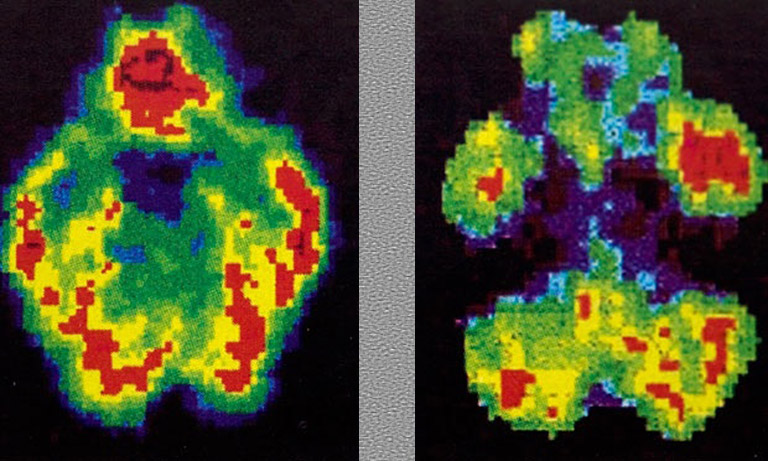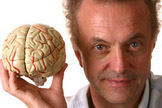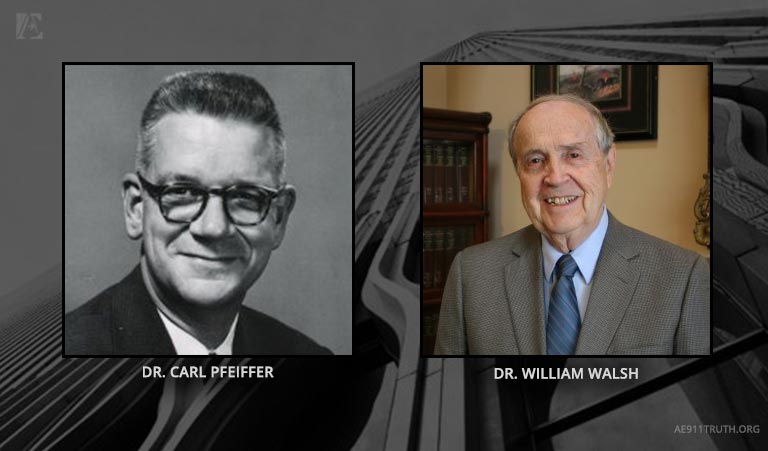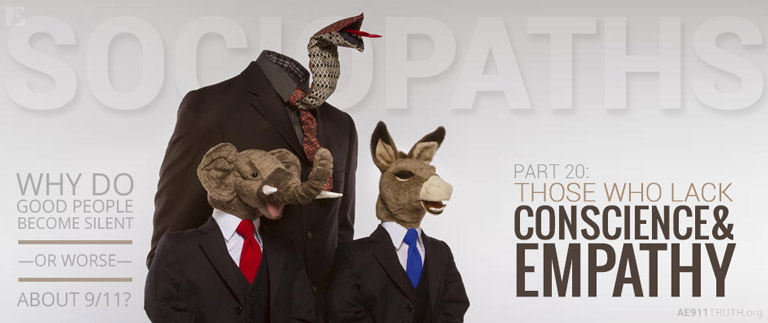 Editor's Note: Frances Shure, M.A., L.P.C., has performed an in-depth analysis addressing a key issue of our time: "Why Do Good People Become Silent — or Worse — About 9/11?" The resulting essay, being presented here as a series, is a synthesis of both academic research and clinical observations.
Editor's Note: Frances Shure, M.A., L.P.C., has performed an in-depth analysis addressing a key issue of our time: "Why Do Good People Become Silent — or Worse — About 9/11?" The resulting essay, being presented here as a series, is a synthesis of both academic research and clinical observations.
Please note that because Architects & Engineers for 9/11 Truth is dedicated to researching and disseminating scientific information about the destruction of three World Trade Center skyscrapers on September 11, 2001, and does not speculate as to the identity or motives of the perpetrators, any reference to names or motives of the attackers in this series of articles, made by either the author or the individuals she quotes, is a personal opinion and not the viewpoint of AE911Truth.
Many people, when confronting the possibility that prominent figures in their own government could have orchestrated the 9/11 attacks, react in horror: “You’ve got to be kidding me! What monsters could have done such a thing?!”
Those who have studied the deep politics of nations throughout history, though, are not so apt to be shocked by this bold charge. As we discovered in Part 19: Government Manipulation and the Big Lie, tens of millions of innocent civilians were monstrously murdered during World War II by the Nazi war machine. The leadership of this juggernaut was attempting to create a “New Order” in which Germans would be the “master race” and most survivors of the juggernaut their slaves.
From the information provided in Gustave Mark Gilbert’s Nuremberg Diary,1 as well as in other sources, we learn that all of the Nazi leaders exhibited clear signs of a compromised conscience and a severely reduced ability to feel empathy for their victims. Their diminished humanity was a result of (1) experiencing extreme childhood trauma;2 (2) growing up in a harsh authoritarian culture, in which suppressing one’s will and conscience and following a superior’s orders with little protest were key requirements;3 and (3) believing, after centuries of hearing treacherous rumors about the Jewish people, that Jewry was locked in an apocalyptic battle with non-Jewish Germans.4
In addition, we recall from Part 19 that psychoanalyst and author Alice Miller, who conducted research on Adolf Hitler, established that Hitler’s father beat him daily for many years, starting at the age of three or four.5 The German leader, therefore, suffered throughout his childhood and adulthood from complex post-traumatic stress disorder (C-PTSD).6
Indeed, German children of that period were commonly subjected to beatings and other sadistic abuse, such as stamping out the will of the child, beginning in infancy. As a result, this extreme abuse generally resulted in unquestioning obedience to authority.7 Hence, many Nazis suffered from C-PTSD, resulting in an inability to empathize with their victims combined with a strong tendency to follow orders from their superiors.
Other psychological reasons for a diminished capacity for empathy include a childhood so bereft of nurturance, love, and secure attachment (known as traumas of omission) or so filled with verbal abuse, sexual abuse, and beatings (known as traumas of commission) — with the two traumas often being concurrent — that the person develops behaviors that are commonly labeled reactive attachment disorder,8 borderline personality disorder, or narcissistic personality disorder.
In his book, Gilbert described the behavior of the Nazi leaders at the Nuremberg trials. Some were emotionally defensive. Others demonstrated what appeared to be genuine remorse and shame when they were finally confronted with witness testimony and films of the atrocities for which they were responsible. A minority of the indicted, however, displayed complete indifference and icy coldness when viewing and hearing the results of their deeds.
It is this minority — the true sociopaths — that we will now discuss. First, though, I want to be clear that when the psychological and cultural conditions set the stage, relatively normal people can commit monstrous atrocities. This point cannot be overstated.
Who is the true sociopath?
According to current research, true sociopaths are estimated to constitute an astounding 4% of the U.S. population.9 While some people draw distinctions between the terms “sociopath” and “psychopath,” popular culture generally uses these terms synonymously, as I do in this essay.
Professional psychologists and psychiatrists, however, do not use these well-known terms. Instead, they use the label “Antisocial Personality Disorder” (APD), which is found in the Diagnostic and Statistical Manual of Mental Disorders, 5th edition (DSM 5) — applying it only to adults. The DSM 5 lists behavioral characteristics only. It does not speculate on the etiology (the cause) of this disorder or comment on effective treatment.
Canadian psychologist Robert D. Hare developed a “Psychopathy Checklist” in order to distinguish the true psychopath from other people who demonstrate a diminished conscience and capacity for empathy. The salient features of true psychopathy are as follows:
| Emotional/Interpersonal | Social Deviance |
| glib and superficial egocentric and grandiose lack of remorse or guilt lack of empathy deceitful and manipulative shallow emotions |
impulsive poor behavior controls need for excitement lack of responsibility early behavior problems adult antisocial behavior |
These characteristics correspond well with the current DSM 5 description of traits that qualify an individual for the diagnosis of Antisocial Personality Disorder.10
The primary manifestation of this personality type is a complete lack of conscience — a lack of morality, ethics, and principles. Additionally, there is an absence of empathy — the ability to identify with what others are feeling. True sociopaths cannot feel close to or connected with other humans or creatures. Though they may be masters at faking the higher human emotions, the only emotions they appear capable of actually feeling are the neurologically “primitive” reactions that result from acute physical pain and pleasure as well as from short-term frustrations and successes.11
Perpetually bored, true sociopaths seek pleasure in exerting power over others and in calculating how to achieve that power. Most sociopaths are not killers, but they satisfy their lust for power by exercising it within their families, in the workplace, or, if they are in a high enough government position, within the power structure of a nation. Meanwhile, the sociopath who does kill does so without anguish.
To the sociopath, other beings, whether family members or neighbors, workmates or strangers, human or nonhuman, are simply objects to be used for his benefit. Even for the nonviolent sociopath, love is not a possibility, nor is love even comprehended.
I have emphasized “true” sociopathy because there are those who may appear to us to be sociopathic but do not actually qualify for this label. As mentioned earlier, these are the people who may suffer from complex post-traumatic stress disorder, reactive attachment disorder, borderline personality disorder, or narcissistic personality disorder. Others may have had severe head injuries that affect their personalities, causing behavior reminiscent of that of psychopaths.12 Some of these apparent psychopaths appear to have a very diminished conscience and capacity for empathy. What usually distinguishes them, however, are the hot emotions common to the rest of us, as opposed to the calculating, icy coldness of the genuinely psychopathic person.13
What causes sociopathy?
While research is nascent, and there is by no means a final verdict on the etiology of this unfortunate condition, brain research demonstrates that these people have abnormal brain chemistry and structure — aberrations that result in an inability to process emotional stimuli:
Brain scans of the antisocial people, compared with a control group of individuals without any mental disorders, showed on average an 18-percent reduction in the volume of the brain's middle frontal gyrus [a ridge of the frontal cortex], and a 9 percent reduction in the volume of the orbital frontal gyrus – two sections in the brain's frontal lobe. . . . In the psychopaths, the researchers observed deformations in another part of the brain called the amygdala, with the psychopaths showing a thinning of the outer layer of that region called the cortex and, on average, an 18-percent volume reduction in this part of brain.
The amygdala is the seat of emotions. Psychopaths suffer from emotional poverty, lacking the normal range and depth of human emotions, such as joy, remorse, empathy, and guilt.14
Additionally, research has been done using resting-state functional Magnetic Resonance Imaging (rs-fMRI). Among its findings:
[The brains of] adjudicated antisocial offenders showed “uncoupled connections” in areas of the frontal and parietal lobes which are associated with attention, self regulation, the ability to control oneself, and [the ability to] resolve conflicts. It was noted that physiological and anatomical deficits observed in the frontal/parietal areas, as well as the cerebellum, may account for the chronic low arousal, high impulsivity, lack of conscience, callousness, and decision-making problems commonly seen in individuals with APD.15
Sociopaths, though often cold and unemotional, can nonetheless be prone to dramatic, yet shallow, displays of feeling. These displays are short-lived, leaving careful observers with the impression that the psychopath is play-acting, with little in the way of thoughts or feelings going on beneath the surface.
 Brain scans of a normal brain (left) and murderer’s brain (right)
Brain scans of a normal brain (left) and murderer’s brain (right)
Interestingly, sociopaths appear incapable of describing the bodily states that accompany their emotions. They wouldn’t be genuinely able to say, for example, “I was so scared that my stomach was churning and my hands were trembling!”
And no wonder! Psychopaths simply do not possess the normal physiological responses associated with fear, according to researchers who have used biomedical recorders to analyze this phenomenon. For most of us, fear is a powerful motivator for action or inaction. Thus, this deficiency in sociopaths is likely the reason they display many of the symptoms listed on Hare’s Psychopathy Checklist — especially poor control of behavior.16 Validating this research, a long-term study determined that three-year-old children who were unable to respond with fear, as measured by their involuntary skin response, became criminals as adults.17
Studies of identical twins strongly indicate that there is a genetic predisposition for the traits of psychopathy. Environment, meanwhile, plays a role in how this predisposition manifests in each individual. This is apparently the reason that sociopaths from more dysfunctional families and neighborhoods are more likely to become violent, be imprisoned, and have a high recidivism rate,18 while sociopaths born into more functional families, living in a better environment, and given superior educational advantages may employ their traits in business or within the power structure of a nation.19
Some researchers see psychopathy as being on a continuum — ranging from the most violent criminals to those individuals who never encounter the law — rather than as a singular condition that is either completely present or completely absent. They haven’t yet determined whether this is due to differences in brain structure or to environmental influences. Nevertheless, violent or not, the true psychopath has a severe emotional handicap that is apparently based in an organic brain disorder.
Other research has discovered that sociopathy is sex-linked, with men much more likely than women to be true sociopaths.20 Curiously, there is no convincing research that links the sociopath’s complete lack of conscience with childhood maltreatment. In fact, sociopaths appear to be less influenced or afflicted by their childhood experiences than the rest of us are.21
Some studies show an unexpected cultural variation in the incidence of true sociopathy. In Taiwan, for example, researchers see a much lower incidence of this condition — only 0.03% to 0.14%. More cooperative cultures apparently keep this condition manageable for their own survival. Either the person afflicted with this dysfunction learns to blend in with the culture that values connectedness and cooperation or he is killed by his peers. For example, the Inuit tolerate a sociopathic brother for a period, but when they have had enough of his destructive behavior, they insist that he join them on a hunting foray. Then, with no one around to witness, he is pushed off the edge of the ice into the sea.22
The dominant Western culture (as opposed to many indigenous cultures) is not based on knowledge of kinship with all beings or on a spirit of cooperation within a community. Instead, we Westerners esteem a go-it-alone, rugged individualism — to the point where we even value the pursuit of domination. The sociopathic, guiltless manipulation of other people, with the goal of financial profit and power over others, is supported to a great extent by our dominant cultural values.
Perhaps we should not be completely surprised, therefore, when we discover that the incidence of sociopathy appears to be on the increase in America. A 1991 study reported that the prevalence of this emotional dysfunction had nearly doubled among the young in the previous 15 years. There is, however, no research that clarifies exactly why this has been occurring.23
Is there healing for the sociopath?
Most professionals concede that they know of no successful therapeutic treatment for the sociopath. In fact, oddly enough, talk therapy and group therapy may make violent sociopaths worse! The reason, speculates Robert Hare, is that “[u]nfortunately, programs of this sort merely provide the psychopath with better ways of manipulating, deceiving, and using people. As one psychopath put it, ‘These programs are like a finishing school. They teach you how to put the squeeze on people.’”24
Hare and fellow psychologists warn that you cannot love away an organic brain disorder! But can it be treated physically?
 Neurocriminalogist Adrian Raine Dr. Adrian Raine, who describes himself as a neurocriminologist, conducted a study with colleagues showing that Omega 3 fats can reduce violent behavior in children. Children, aged eight to sixteen, were given Omega 3 fats regularly for six months. Parents reported that their children exhibited a 42% reduction in scores on “externalizing” aggressive and antisocial behavior, such as getting into fights and lying. These children also had a whopping 62% reduction in “internalizing” behavior, such as depression, anxiety, and withdrawal.25
Neurocriminalogist Adrian Raine Dr. Adrian Raine, who describes himself as a neurocriminologist, conducted a study with colleagues showing that Omega 3 fats can reduce violent behavior in children. Children, aged eight to sixteen, were given Omega 3 fats regularly for six months. Parents reported that their children exhibited a 42% reduction in scores on “externalizing” aggressive and antisocial behavior, such as getting into fights and lying. These children also had a whopping 62% reduction in “internalizing” behavior, such as depression, anxiety, and withdrawal.25
What could account for this success? The answer is likely related to the fact that Omega 3s play a critical role in brain development and function.
Another clue to possible treatment and even healing for the true sociopath (especially if begun at an early age) may be gleaned from the collaborative work of chemical engineer Dr. William Walsh and the world-renowned Dr. Carl Pfeiffer, who studied nutrient therapies for patients with behavior disorders — disorders that in children are often predictive of adult APD. In 12 years of research, Pfeiffer and Walsh used nutrient therapy to treat 500 persons who had behavioral disorders. Most of the adults treated were prone to noncompliance, so, not surprisingly, they failed to achieve long-term improvements. Two-thirds of the parents of the violent children, however, reported great benefits, with violent episodes and destruction of property either ceasing or become less frequent.26
One of the intriguing aspects of William Walsh’s research is the likely role of epigenetics27 in the etiology of autism, schizophrenia, and other mental disorders, possibly including antisocial personality disorder. A detailed explanation of this fascinating new research is beyond the scope of this essay, but can be found in Walsh’s Nutrient Power: Heal Your Biochemistry and Heal Your Brain.28

Brain researcher Jim Fallon offers a fascinating example of a psychopathic anomaly. Fallon was studying the brain scans of psychopaths, and one day he decided to look at his own. To his dismay, he discovered that he had the brain signature of a psychopath! Oddly enough, though, his behavior didn’t manifest this condition. How could this be? He turned to his mother for a clue. She revealed that his genetic history, through his father, is filled with a long line of psychopaths, including the infamous Lizzi Borden. Fallon speculates that because his childhood was free of emotional trauma, his genes for the affliction of psychopathy were not activated by environmental stressors. This fact led him to the hypothesis that psychopathy may be an epigenetic disorder. 29
Admittedly, Fallon’s conclusion is highly speculative, especially given that the bulk of the research provides a very different picture of young sociopaths growing up in good families. Nonetheless, brain researcher Adrian Raine recounts an anomalous story similar to the one told by Fallon. Raine’s brain scan shows characteristics similar to the psychopaths he studies — and indeed, his behavior in childhood did have the violent earmarks of a sociopath. But when he turned 11, Raine “changed schools, got more interested in studying and really became a different sort of kid.”30
Not surprisingly, both Fallon and Raine emphasize the importance of both nature (our genes) and nurture (our environment) in the development of each individual — even of psychopaths.
As we have already mentioned, behavior disorders in the young, such as the violent childhood behavior of Raine, can be a predictor of sociopathy in adulthood.
Take the 35 years of research that William Walsh has done. In that time, he built a massive database of 10,000 patients with behavioral disorders. He found in this group a 94% incidence of chemical imbalances with known impacts on brain functioning. Males in his database outnumbered females by a three-to-one ratio.31
Walsh discovered specific chemical signatures for each of the following disorders: intermittent explosive disorder, oppositional-defiant disorder, conduct disorder, nonviolent behavior disorders, ADHD, and antisocial personality disorder. It is the last of these that greatly interests us in this analysis. Walsh’s research demonstrated the following:
The chemical signature of ASPD [antisocial personality disorder] is an odd combination of undermethylation, pyrrole disorder, elevated toxic metals, severe zinc deficiency, and low-normal copper levels. Nutrient therapy to correct these imbalances generally results in reports of great improvement in ASPD children, but there is little sustainable benefit for teens or adults actively abusing alcohol or illegal drugs. This condition is treatable, but early intervention is essential.32
Books on psychopathy often stir up in readers a dread of being manipulated by psychopaths. This fear is understandable, given that psychopaths, whether violent or not, are usually dangerous. We obviously need to know how to protect ourselves from their predations.
Nonetheless, I prefer to look beyond fear and provide a perspective of hope. To me, the research done to date provides this hopeful message: Current lack of effective treatment for antisocial personality disorder does not mean that the future will be as bleak. That said, the facts demonstrate that early intervention is essential. While more research is needed, intervention in select cases could actually be implemented today, as we already have the necessary tools and knowledge that point us in the direction of prevention and healing.
For instance, now that we have brain scans,33 biochemical assays, and other tests for children who display pervasive and violent disregard for the lives of people, animals, and property, it is possible for parents to determine if their child has the brain and biochemical signatures of someone who is likely to become a true sociopath. In this early stage, before the child’s brain is fully developed, nutrient intervention may be successful in offering these children a more normal life — perhaps even one with the possibility of connection, empathy, and love.
Any course of action requires the highest ethics on the part of the professionals and the parents. The anomalies of Jim Fallon and Adrian Raine mandate that we take the utmost care in performing interventions. One might well question, however, whether our culture is wise enough to choose a non-obligatory course of compassionate prevention of sociopathic destructive behavior. Case in point: A wiser culture than ours would reward cooperation — making sure that all have their basic needs met — rather than rewarding the pursuit of dominance over others.
How do we protect ourselves from sociopathic predators?
If we find ourselves the victims of a sociopath, we should hardly be surprised, given that sociopaths are masters of lying, deceiving, and manipulating. In one way or another, their goal is to gain our trust, which becomes a doorway to our hearts, our sexual responses, and/or our wallets — that is, if we are fortunate enough to not to be the victims of their physical violence. To the sociopath, people are simply marks, objects to be manipulated and exploited.
What are the sociopath’s signposts? Besides the characteristics cited in the Psychopath Checklist, the following traits are all typical: a smooth lack of concern as his lies are exposed; a charismatic charm; a cool, self-assured, brazen manner; piercing eye contact or unnaturally flattened eyes; and impulsive and risky behavior. Other clues include emotions that come across as shallow, manipulative, short-lived, and unconvincing — and any proffered deal that sounds too good to be true.34
We can also adopt the protective strategy of learning how to recognize the telltale signs of lying. The New York Times’ bestseller, Spy the Lie: Former CIA Officers Teach How to Detect Deception, has invaluable suggestions of signs to watch for.35 One unique indicator that a sociopath is lying is his uncanny ability to contradict himself brazenly from one sentence to the next.
Perhaps the most essential defense against being taken in by the sociopath is to recognize our own needs for love and safety — needs that may have been unmet in our childhood and that still linger today. Any predator, but especially the sociopath, instantly recognizes and preys upon our emotional needs. He will skillfully tell us whatever we want to hear. And since he has honed his skills of deception and predation, we must hone our own skill at identifying his skills, so that our intuition, our sixth sense, our radar — whatever you may call it — is tuned to pick up on deceit and predatory tactics.
If we find we have a pattern of succumbing to sociopathic manipulations, we may want to seek professional help in discovering and healing our own unconscious traumas of omission and commission — and the resulting vulnerability left in their wake. Without this healing, our radar, designed to warn us that we are being played by a sociopath, will probably not function correctly.
Conclusion
When confronted with the assertion that our fellow Americans could never wittingly commit such a monstrosity as 9/11, we may readily agree that most of us, whether government officials or members of the public, could not participate in such an evil act, but we might also add the following facts:
1) The Milgram experiments proved that two-thirds of Americans, upon receiving orders from an authority figure, are capable of administering a fatal electric shock to someone they believe has a heart condition. Similarly, Philip Zimbardo’s Stanford Prison Experiment demonstrated that normal students, following the instructions of an authority figure, would treat their fellow classmates sadistically. (For both of these experiments, see Part 3: Obeying and Believing Authority.)
2) The Nazi leaders, many of whom were not true sociopaths but were likely traumatized as children (as was their Führer), set in motion a killing spree that resulted in the brutal extermination of tens of millions of innocents. Their rampage (not the first mass slaughter in history, and doubtlessly not the last) reinforced the sad fact of our human condition: When the psychological and cultural conditions are supportive, relatively normal people can commit monstrous atrocities.
3) Based upon historical documents, we can safely say that some of those responsible for these Nazi crimes were almost certainly true sociopaths.
4) Current research indicates that as many as 4% of Americans are true psychopaths. By definition, any psychopath is capable of participating in mass murder and expressing no remorse whatsoever.
Nationality aside, research shows that some humans who may appear relatively normal on the surface in reality conceal emotionally excruciating trauma that they experienced as infants and children, resulting in severe emotional dysfunction, including a diminished conscience and a diminished capacity for empathy. Other research indicates that some humans are afflicted with an organic brain disorder and the biochemical signatures associated with psychopathy.
The future may offer both prevention and healing for all of these unfortunates. For now, though, they are the “monsters” in our midst who are capable of enacting atrocities such as 9/11. Their violent actions are incomprehensible to those of us who are fortunate enough to be gifted with a conscience and with empathy for others.
We will now transition to a subject that is arguably the most important in answering the overarching question in the title of this essay; the role of the media in promoting silence — or worse — about 9/11.
Endnotes
1G. M. Gilbert, Nuremberg Diary (First Da Capo Press edition, 1995).
2Robin Grille, Parenting for a Peaceful World (Longueville Media, PO Box 7143 Alexandria, New South Wales 2015, Australia, 2005), Chapter 13 “Nazis and their opponents: how did their childhoods differ?”
Alice Miller, For Your Own Good: Hidden cruelty in child-rearing and the roots of violence (Farrar, Straus and Giroux, New York, 2002).
3Miller, For Your Own Good, 3 – 91.
4Daniel Jonah Goldhagen, Hitler’s Willing Executioners: Ordinary Germans and the Holocaust (Alfred A. Knopf, Inc., 1996).
5Alice Miller, For Your Own Good. 142 – 197.
6Complex-Post Traumatic Stress Disorder (C-PTSD) is not listed in the DSM 5, but some psychology professionals believe it should be since it refers to repetitive, severe, and often early childhood trauma that can result in attachment disorder, borderline personality disorder, and other emotional dysfunctions. This diagnosis better describes the etiology of many common emotional issues than does Post Traumatic Stress Disorder (PTSD), which was originally developed to describe the victim of a single trauma, such as rape, or a traumatic war experience.
7Miller, For Your Own Good, 3 – 102. These two chapters, describing a “poisonous pedagogy,” clearly show the very early origins of the authoritarian personality, including the loss of the authentic self, and thus the origins of an authoritarian and sadistic culture.
Grille, Parenting for a Peaceful World, 119 – 140.
8Studies by Harry Harlow and James W. Prescott show that severe brain impairment results from the deprivation of mothering care, causing experimental monkeys to be antisocial, depressed, violent, and attachment disordered. John Bowlby and Renee Spitz studied children institutionalized in orphanages after World War II. They found that these children displayed severe impairments, disturbingly similar to the unfortunate experimental monkeys.
It is the cerebellum and the septum pellucidum that are impaired due to lack of mothering love and touch. A sane and peaceful world, therefore, will not be possible without society’s support of healthy, uninterrupted infant-mother bonding. “Mothering care” means care by a primary caretaker who becomes the “mother” to the infant.
See the research of James W. Prescott, Ph.D., at http://violence.de, and purchase the fascinating DVD Rock A Bye Baby (a Time Life production) documenting Prescott and others’ research at http://ttfuture.org/bonding/dvd_archive/overview, or view at http://www.violence.de/tv/rockabye.html.
See also
http://www.nytimes.com/1988/02/02/science/the-experience-of-touch-research-points-to-a-critical-role.html?pagewanted=all&src=pm.
9Martha Stout, The Sociopath Next Door (Three Rivers Press, 2006) 6.
Note: The 4% figure may be open to debate. In the United Kingdom, researchers have determined the condition of psychopathy to be 0.6%. See Philip Hunter, “The Psycho Gene,” http://www.ncbi.nlm.nih.gov/pmc/articles/PMC2933872.
10Robert D. Hare, Without Conscience: The Disturbing World of the Psychopaths Among Us. (The Guilford Press, 1999) 34. Note: Hare cautions that the “Psychopathy Checklist” is a complex tool for professional use, and not for the lay person to diagnose self or others.
For comparison with the DSM 5 criteria, see David Porter, “Antisocial Personality Disorder DSM-5 301.7 (F60.2)” at
http://www.theravive.com/therapedia/Antisocial-Personality-Disorder-DSM--5-301.7-%28F60.2%29.
11Stout, The Sociopath Next Door.
12Hare, Without Conscience, 169.
13Stout, The Sociopath Next Door. 126.
14Clara Moskowitz, “Criminal Minds Are Different From Yours, Brain Scans Reveal,” From
http://www.livescience.com/13083-criminals-brain-neuroscience-ethics.html.
15David Porter, Antisocial Personality Disorder DSM-5 301.7 (F60.2), at
http://www.theravive.com/therapedia/Antisocial-Personality-Disorder-DSM--5-301.7-%28F60.2%29. Original research is found at
http://www.ncbi.nlm.nih.gov/pmc/articles/PMC3625191.
16Hare, Without Conscience, 52 – 56.
17Moskowitz, at
http://www.livescience.com/13083-criminals-brain-neuroscience-ethics.html.
18Hare, Without Conscience, 95 – 97.
19Ibid. 173 – 175.
Stout, The Sociopath Next Door, 120 – 139.
See also Clive R. Boddy, “The Corporate Psychopaths Theory of the Global Financial Crisis,” The Journal of Business Ethics 102, no. 2 (August 2011), 155–159.
20See “Jim Fallon: Exploring the mind of a killer” at
http://www.youtube.com/watch?NR=1&feature=endscreen&v=u2V0vOFexY4.
See also Philip Hunter, “The Psycho Gene,”
http://www.ncbi.nlm.nih.gov/pmc/articles/PMC2933872.
21Stout, The Sociopath Next Door.
22Ibid.
23Ibid.
24Hare, Without Conscience,” 199.
25Janice Wood, “Omega-3 Show to Reduce Antisocial, Aggressive Behavior in Kids” at
http://psychcentral.com/news/2015/05/18/omega-3-shown-to-reduce-antisocial-aggressive-behavior-in-kids/84697.html.
26William J. Walsh, Nutrient Power: Heal Your Biochemistry and Heal Your Brain (Skyhorse Publishing, 2014), Chapter 8.
27Epigenetics is the study of how biochemical “bookmarks” specify the combination of proteins to be manufactured by each gene in each cell, producing specialization, such as liver, eyes, or enzymes. This is a normal process that begins at conception and continues throughout life. A malfunction of this process occurs when environmental stressors (such as toxic chemicals, emotional trauma, oxidative stress, medication side effects, nuclear radiation, and abnormal nutrient levels) trigger an abnormal biochemical reaction resulting in abnormal proteins — and thus an epigenetic disorder — for that unfortunate individual.
28Walsh, Nutrient Power, Chapter 4. See also
http://www.walshinstitute.org/researchstudies.html.
29See Jim Fallon, “Exploring the Mind of a Killer.” This TED Talk introduces the concept of “epigenetics,” whereby a vulnerable gene is “turned on” by a severe childhood stress,
http://www.youtube.com/watch?NR=1&feature=endscreen&v=u2V0vOFexY4.
30Tim Adams, “How to Spot a Murder’s Brain,” at
http://www.theguardian.com/science/2013/may/12/how-to-spot-a-murderers-brain.
31Walsh, Nutrient Power, Chapter 8.
32Ibid. 123.
33SPECT scans (single-photon emission computed tomography), PET scans (positron emission tomography), and resting state functional Magnetic Resonance Imaging (rs-fMRI) are currently used to show brain activity.
34See Hare, Without Conscience, for much more detail on these signposts.
35Phillip Houston, Michael Floyd, and Susan Carnicero, Spy the Lie: Former CIA Officers Teach You How to Detect Deception (St. Martin’s Press, 2012).
For a review of this book and examples on how to apply this knowledge to the subject of 9/11, see
http://www.washingtonsblog.com/2015/10/how-to-spy-the-911-lie.html.
Note: Electronic sources in the endnotes have been archived. If they can no longer be found by a search on the Internet, readers desiring a copy may contact Frances Shure [This email address is being protected from spambots. You need JavaScript enabled to view it.].




